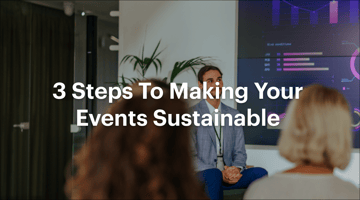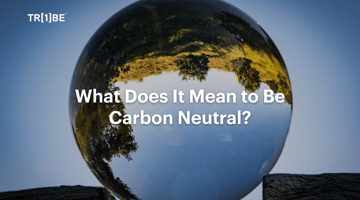Download One Tribe's 'Sustainability Checklist' and learn how to make your events sustainable while...
The Correct Way To Purchase Nature-Based Offsets

Introduction
Climate change is one of the biggest challenges we face today, and addressing it requires a collective effort from individuals and organisations worldwide. Businesses and large corporations are turning to carbon offsets as a way to mitigate their carbon emissions and lower their environmental impact but at what environmental cost?
Investing in nature-based offsets can provide a powerful tool to mitigate carbon emissions while supporting the preservation and restoration of natural systems and is quickly becoming a preferred project type across the voluntary carbon market (VCM).
Purchasing nature-based offsets can be a complex process, and it’s important to ensure that offsets meet the standards set out by project certifying bodies including Verra and the Gold Standard. In this article, we will explore how to purchase nature-based offsets and provide tips for ensuring that your investment delivers meaningful environmental and social benefits.
What Are Nature-Based Solutions?
Nature-based solutions, also referred to as nature-based offsets, are a type of carbon offset that involves activities that either conserve, restore, or enhance natural ecosystems. Such activities can include reforestation, afforestation, sustainable agriculture, and conservation among other efforts that improve or benefit natural landscapes and ecosystems.
Nature-based solutions work by capturing and storing carbon dioxide from the atmosphere as a means to offset the emissions produced by individuals or businesses.
The United Nations and the Intergovernmental Panel on Climate Change (IPCC) recognise nature-based solutions as an effective method of mitigating climate change. These solutions are founded on the premise that natural ecosystems have the ability to capture and store large amounts of carbon, and that enhancing these ecosystems can help to reduce large quantities of carbon dioxide from the atmosphere.
By investing in nature-based carbon offsets, individuals and businesses can successfully mitigate climate change, while also supporting the preservation and enhancement of natural ecosystems.

Why Is It Important To Purchase Credible Carbon Offsets?
Carbon offsets are only effective in reducing greenhouse gas emissions if they are certified by official offset regulators and are proven to have a measurable impact on reducing carbon emissions. A lack of coherent policies within the voluntary carbon market (VCM) has led to some credits being criticised for not delivering the promised benefits. However, better reporting and rigid vetting processes has meant that new policies are being introduced regularly to repair the existing issues surrounding carbon offsets.
To ensure that the carbon offsets purchased are credible and have a real impact on reducing emissions, it’s important to verify that the offsets meet certain criteria, such as those set by Verra and The Gold Standard.
What Is The Verra Offset Criteria?

Verra is a non-profit organisation and one of the world’s leading panels that conduct the official standards for carbon offset projects. Their standards are widely recognised as being credible and rigorous, and many organisations, including the United Nations, use their standards to evaluate and certify carbon offset projects.
To ensure that the carbon offsets purchased meet the Verra Offset Criteria, it’s important to look for projects that have been reviewed and certified by Verra. Verra’s standards require that projects meet several criteria, including the following:
- Real and measurable emissions reductions: Projects must ensure net reduction or removal of greenhouse gas emissions that are both measurable and verifiable.
- Additionality: The project must go above and beyond what would have happened without the project, meaning that it would not have occurred without the revenue from the sale of VCUs.
- Permanence: Projects in the Agriculture, Forestry, and Other Land Use (AFOLU) sector must ensure GHG removals are not lost due to unforeseen events such as fire or disease.
- Avoidance of double counting: The emissions reductions must not be counted multiple times, which can occur if the same carbon reduction is sold to multiple buyers.
- Sustainable development: The project must have social and environmental co-benefits and not have negative impacts on local communities or ecosystems.
By ensuring that the carbon offsets purchased meet the Verra Offset Criteria, individuals and businesses can be confident that they are making a genuine and measurable contribution to reducing greenhouse gas emissions.
While carbon offsets can be an effective tool in mitigating the effects of climate change, it is important to remember that purchasing credits should be used primarily as a last step process once attempts to actively reduce emissions across scope 1, 2, and 3 areas of the business have been reduced.
What Is The Gold Standard?

The Gold Standard is a certification panel for carbon offset projects that meet rigorous standards for social and environmental sustainability, as well as carbon emissions reductions. The Gold Standard is widely recognised as being one of the most credible and rigorous certification programs for carbon offset projects alongside Verra.
To ensure that the carbon offsets purchased meet the Gold Standard, it’s important to look for projects that have been certified under the official Gold Standard criteria. The Gold Standard’s criteria for carbon offset projects include:
- Real and verifiable emissions reductions: The project must result in the reduction or removal of greenhouse gas emissions that are measurable and verifiable.
- Sustainable development: The project must have social and environmental co-benefits and not have negative impacts on local communities or ecosystems.
- Project monitoring: Annual Reports capturing any parameters that are required to be monitored and assessment of Safeguarding principles & requirements.
- Additionality: All projects must demonstrate impacts that go beyond “business-as-usual” and demonstrate financial additionality and an ongoing financial need.
How To Buy Your First Carbon Credit
The process of buying carbon credits through Verra or the Gold Standard typically involves an eight step process that requires businesses to measure their existing footprint and choose an appropriate offsetting method to support their business requirements.
1) Audit You Emissions
Buying carbon credits forest requires identifying the emissions that need to be offset. This involves any calculation regarding the carbon footprint of daily business activity, typically referred to as a ‘carbon footprint’. Your carbon footprint measures the total amount of greenhouse gas emissions that are directly and indirectly generated by business operations. This includes emissions from energy use, transportation, waste, supply chain processes, amongst other activities.
The calculation process is broken down into the measurement of scope 1,2, and 3 emissions. During emissions reduction scope 1 and 2 involve methods and strategies that aim to directly decrease emissions. If there are unavoidable emissions remaining, such as those from industrial processes or long-distance transportation, offsetting can be considered to neutralise your climate impact. It’s important to understand that offsets should not be viewed as a substitute for taking direct action to reduce emissions, but rather as a complement to those efforts.
Offset purchases should be guided by a thorough understanding of the project’s additionality, permanence, and verification to ensure they meet high standards and deliver meaningful climate benefits.

2) Calculate Your Offset Requirements
The next step is to directly calculate the number of carbon credits needed to offset the identified emissions. Each carbon credit represents one metric ton of carbon dioxide equivalent (CO2e) that has been reduced, avoided, or removed from the atmosphere through the certified project. The number of carbon credits needed is calculated based on the emissions that need to be offset.
This will help you to determine the number of offsets required to purchase and how effective they will be at offsetting emissions that directly correlate to your own business activities.
3) Choose An Offset Project
Once you have made the decision to purchase carbon credits, you will need to choose the type of carbon offset project to invest in.
Choose a project that aligns with the objectives or needs of your business such as the quantity of emissions which need removing or the type of project that has the least impact on the environment. Your selection process should consider the location of the project, the co-benefits that it provides, and the specific emissions that it addresses. In the case of nature-based solutions, Improved Forest Management and Avoided Conversion projects have been shown to sequester significant amounts of carbon and preserve biodiversity.
To find projects, research different carbon credit suppliers, and third-party organisations, such as Verra and Gold Standard, that offer a range of carbon offset projects to choose from. Once a project has been selected, the company should contact the project developer to confirm availability and negotiate the price.

By choosing nature-based solutions as an offset method, companies can not only reduce their carbon footprint but also promote sustainable development and contribute to global climate action.
4) Purchase Credits
Once you have determined your emissions, the necessary offsetting requirements and your desired project, the next step is to purchase the required number of carbon credits from the Verra or The Gold Standard registry or a certified third-party vendor.
The cost of carbon credits can vary depending on the project type, location, and other factors, so it is important to compare and evaluate projects to find one that is most beneficial to you.
5) Retire The Credits
After purchasing carbon credits you will need to retire them in the registry to ensure that they cannot be resold or double-counted. This step is important to ensure that the purchased carbon credits are not used by another party to offset their emissions.
6) Monitor And Report
The final step in the process of buying carbon credits is to monitor and report on the project’s ongoing emissions reductions and environmental co-benefits. This involves tracking the progress of the project and reporting on the emissions reductions and other benefits that it provides. This step is important to ensure that the project continues to meet the certification standards of Verra or The Gold Standard.
By following these steps, individuals and businesses can ensure that they are purchasing high-quality, verified carbon credits that contribute to the mitigation of climate change and the preservation of natural ecosystems. One Tribe, a climate action platform in partnership with Verra, Gold Standard, CEDIA and the UNFCCC, assists businesses in purchasing reliable nature-based carbon offsets, alongside supporting businesses in their journey to net zero. Even for those that are unsure where to start, One Tribe can help you to take your first step towards an improved carbon footprint.
Summary
Investing in nature-based offsets can provide multiple benefits beyond carbon reduction, including preserving biodiversity, enhancing ecosystem services, and supporting local communities. Nature-based solutions have the potential to address the dual challenges of climate change and biodiversity loss. By investing in high-quality nature-based projects, individuals and organisations can take action to support the protection and restoration of natural systems while mitigating their carbon footprint.


